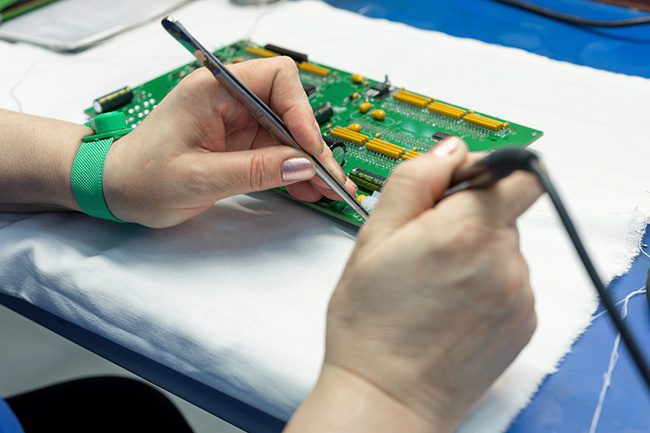IPCA610 Standard Certification in Electronic Manufacturing

At a very basic level, IPC-A-610 amounts to high-level inspection and passage requirements for printed circuit board (PCB) assemblies in electronic manufacturing.
More specifically, it is a set of globally adopted acceptability of electronic assemblies criteria established by the IPC and designed to ensure high quality and high reliability PCB end products.
Through the application of the rigorous IPC-A-610 standards, a manufacturer demonstrates a commitment to customer needs, continuous improvement and underscores additional quality assurance certifications, such as IS0-9001 or AS9100.
Because of the widespread acceptance and use of this certification, it grants a great deal of legitimacy and recognition throughout the industry
Why is IPC-A-610 important?
Beyond the product integrity demonstrated by an IPC-A-610 certification, adherence to the standard indicates an understanding of many technical quality requirements.
As the IPC-A-610 certification is designed by the electronics industry, it follows that many of the technical standards are soldering-related. Examples include standards for lead free connections, requirements for connecting to terminals and for plated-through holes.
Additionally, surface mounting criteria, jumper wire assembly requirements, component mounting, damage, cleaning, and coating criteria are covered.
These and dozens of other standards help define what is considered an acceptable circuit board assembly product. And while there are basic standards generally covered by IPC-A-610, there are levels of acceptability, determined by the products or designers themselves.
Three Classes of IPC-A-610
The IPC-A-610 standards leave room within their three classes for the intended end-item use. Electrical and electronic assemblies vary widely in how they must be produced and how they will be used. Thus, three classes were established to respond to the range of complexity, functional performance requirements, and testing frequency of the products produced in the industry.
The customer or designer bears the responsibility of defining the product class for each of their assemblies. This determination must be spelled out in the documentation laying out the production and assembly of each product.
The classes standardize what is acceptable in each group, with class 1 being the least stringent and class 3 the most. The standards of each class establish a level of quality per the class requirements and consequently communicate that level of quality across the industry.
The basic qualifications for each class are:
CLASS 1: General Electronic Products – This is the most lenient class, with major emphasis on the function of the completed assembly. General electronic products could be inexpensive toys or household items. These products are not expected to last long and are manufactured to match a predetermined price point. Usually the goal is to keep the product as inexpensive as possible, but still working.
CLASS 2: Dedicated Service Electronic Products – Products in class 2 carry an expectation of longer-term reliability, performance, and extended life, though it is not critical. Typically, products in this class would not experience failure caused by the end-use environment. This class allows for some level of imperfection, though it would usually be superficial, rather than functional.
Includes products where continued performance and extended life is required, and for which uninterrupted service is desired but not critical. Typically the end-use environment would not cause failures.
CLASS 3: High Performance/Harsh Environment Electronic Products – Class 3 is the highest standard within IPC-A-610, and more than likely the highest cost. Additional inspections, reworking and slowed production time (to ensure absolute accuracy) all account for the increased cost of manufacturing the highest-standard products. This class is for products where high performance or performance-on-demand is critical. These products cannot tolerate downtime, even as they may be used in uncommonly harsh environments. Life support and critical systems would fall into this category.
IPC-A-610 In Action
It’s easy to overlook the interconnected nature of the classes. Take, for example, an aircraft. Given the high-level functioning they require, you might think it would be all class 3.
However, an aircraft is a good example of something that may have assemblies on board from all three classes.
The flight controls would most likely be Class 3 since it is imperative that the fly-by-wire controls function every time, all the time, and may be exposed to extremes of temperature/vibration at altitude.
Inside the aircraft, the electronics for the entertainment system or the flight attendant call button may be a Class 2 or even a Class 1 assembly.
The design submitted by the original equipment manufacturer (OEM) to the Federal Aviation Administration will specify at what class each assembly should be inspected. Then, when the assembly is manufactured, the inspection would be characterized by the specified class.
IPC-A-610, Another Quality Standard at Levison Enterprises
IPC-A-610 is another quality certification that Levison Enterprises is proud to maintain. As a high-quality electronic contract manufacturer, it only makes sense for us to uphold the highest standards for electronic manufacturing.
We take pride in always offering the best quality available to our partners.
Let’s talk about how Levison Enterprises’ reputation for quality electronics manufacturing can be of service to you and your assemblies.